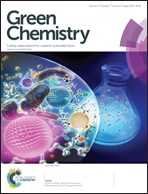On the development of a facile approach based on the use of ionic liquids: preparation of PLLA (sc-PLA)/high surface area nano-graphite systems
Abstract
In this work, a novel method to prepare composite systems based on polylactide (PLA) and high surface area nano-graphite (HSAG) has been developed, consisting of the application of ionic liquids (ILs) as dispersing/exfoliating agents for nanofillers. Indeed, the proposed approach is easy as well as with a low environmental impact, involving neither the use of co-solvents nor the preliminary oxidation of graphite. As a preparatory screening, systems based on either poly(L-lactide) (PLLA), or an equimolar mixture of poly(L-lactide) (PLLA) and poly(D-lactide) PDLA, and ionic liquids are prepared by melt-blending the polymer matrices with different kinds and amounts of imidazolium-type ILs. Among the tested ILs, 1-butyl-3-methylimidazoliumhexa-fluorophosphate ([bmim][PF6]) shows the highest solubility and the lowest tendency to decompose the polymer matrix during the processing. DSC and TGA measurements highlight that the above IL induces a slightly plasticizing effect on PLLA, with a limited decrease – of about 20 °C for the sample with the highest amount of [bmim][PF6] – of the onset degradation temperature. As evidenced by FE-SEM measurements, the chosen IL features a high sonication-assisted capability of dispersing/exfoliating the nano-graphite, thus allowing obtaining a system containing 2% by mass of the nanofiller, organized in aggregates with an average dimension of 300 nm and composed of few layers. Conversely to the direct insertion of the HSAG into the polymer matrix (which produces micrometer-sized aggregates) when the previously-prepared [bmim][PF6]/HSAG system is incorporated, a submicrometric dispersion of the nano-graphite is obtained. The presence of the finely dispersed nanofiller has a nucleating effect on PLLA crystallization, significantly increasing the crystal nucleation density. Moreover, it is of utmost relevance that, in the case of the stereocomplex-PLA-based systems, the HSAG promotes the exclusive formation of stereocomplex crystals over homo-crystals.


 Please wait while we load your content...
Please wait while we load your content...